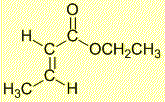Part 8: SPECTROSCOPY
The following data is available from the
question.
Note
: Remember to cross
reference things to confirm.... e.g.
IR may show C=C, use NMR to
confirm that etc.
MS: M+
seen at 114 g/mol, absence of m,m+2 pattern suggests no Cl or Br.
IR:
There is a strong absorption at about 1722 cm-1 which is probably C=O (note that's about normal for a ketone) and maybe at 1186 cm-1 which is probably C-O. There is an absorption at 1652 cm-1 which is probably C=C but no other absorptions of note.... no OH, NH, C≡C or C≡N
13C NMR:
The normal proton decoupled spectrum shows a total of 6 peaks indicating 6 types of
C. By analysis of the chemical shifts, we have a peak at 168 ppm (C=O in the carboxylic acid derivative range), 141 and 123ppm (C=C), 61ppm (maybe a deshielded sp3C) and peaks at 18 & 14ppm that are
most likely from another sp3 hydrocarbon.
1H NMR:
The proton spectrum shows a total of 5 sets of peaks indicating 5 types of H.
|
d/ppm
|
multiplicity
|
integration
|
Inference
|
| 7.0 |
dq |
1 |
=C-H coupled to 3H and 1H |
|
5.9
|
d
|
1
|
=C-H coupled to 1H (J=16 Hz) |
| 4.2 |
q
|
2
|
CH2 coupled to 3H, deshielded |
|
1.9
|
dd
|
3
|
CH3 coupled to 2 x 1H |
| 1.3 |
t |
3 |
CH3 coupled to 2H |
(dq = doublet of quartets, dd = doublet of doublets, q = quartet, t = triplet, d = doublet, s = singlet)
The most significant structural information
from this are:
- adding integrals shows 10H (or a multiple thereof)
- there are coupling patterns to decipher
Summary....
The MS indicated MW = 114.
The IR showed the presence of C=O
13C NMR shows 6 C types including C=O that is most likely a carboxylic acid or derivative. Since there is no RCO2H in the HNMR (12 ppm) or -OH in the IR, it can not be a carboxylic acid.
13C NMR shows 2 C types in the sp2 C region and the H NMR 2 sp2C-H therefore we have a disubstituted alkene.
H NMR gives disubs alkene, -CH2-, and 2 x -CH3 groups.
This information suggests an initial molecular formula = C6H10O
which gives MW = (6x12) + (10x1) + 16 = 98 i.e. missing 16 = O.
Therefore, molecular formula = C6H10O2 and has an IHD = 2 consistent with the C=O and a C=C.
Altogether...
|
The fragments we have are:

The IR, 13C and molecular formula imply that the C=O carbonyl is part of an ester.
The H-NMR 2H quartet at 4.2 ppm and 3H triplet at 1.3 ppm indicate an ethyl group, -CH2CH3.
Given the chemical shift of the -CH2- it is likely attached to -O- so we have an ethoxy group : -OCH2CH3 in an ester.

The other coupling patterns are more complex. The methyl group at 1.9ppm is coupled to both the 2H on the double bond with 2 different coupling constants (hence the dd) and the vinyl H have quite different couplings to the methyl group suggesting that they are on different C (i.e. 1,2-) rather than the same C (i.e. 1,1-). This means we have CH3CH=CH-

Last step is the alkene substitution pattern. The observed H NMR alkene coupling constant (stated on HNMR) of 16Hz is consistent with a trans-alkene |

ethyl trans-but-2-enoate
|
The final step should always be to check what you
have drawn. The easiest thing to check is usually the coupling patterns you
would expect to see, and the chemical shifts of each unit. You should
be asking yourself : "Does my answer give me what the H-NMR shows ?"
Common errors:
MS incorrectly read the MW for the identified M+ (check the scale).
13C NMR ignored the specifics of the C=O range (i.e. subtype :168 ppm < 190 therefore it's a carboxylic acid or derivative)
H NMR had hydrocarbon pieces that did not fit the integration and coupling patterns
General
- did not check MW with data from MS
- wrong type of C=O (look at 13C NMR C=O range and check IR frequency)
- did not check HNMR integration for number of H on the alkene and hence had incorrect substitution of the alkene.
- did not use the available information to check the alkene stereochemistry or just ignored it.
![[Home]](../mol.gif)




![[Home]](../mol.gif)